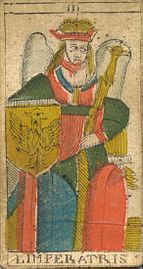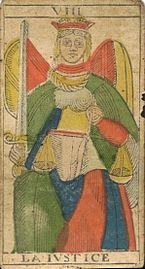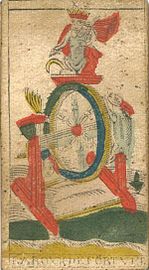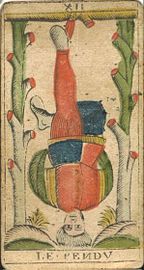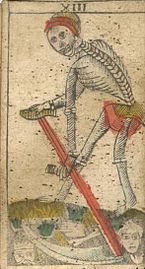Besançon tarot
As Besançon Tarot , also Swiss Tarot or unspecific de tarot Besançon , a type of is Tarot - Deck referred extending from the older forms of card sets from Marseille type derived, has but characteristic differences.
Cards of this type were mainly produced in Switzerland from the middle of the 18th century. The name comes from the southern French city of Besançon , to which the manufacturers relocated production at the beginning of the 19th century. However, the maps were not only produced in Switzerland or Besançon, but also from around 1750 in an extensive area that included southern France, Switzerland and also southern Germany.
A characteristic of card sets of the Besançon type is that the cards, traditionally referred to as The Pope and The Pope , show the Roman deities Juno and Jupiter instead of Pope and Pope . It is assumed that this renaming was done in order to avoid the violation of religious sensitivities in a distribution area characterized by denominational differences.
Other special features of the Besançon type compared to the Marseille tarot are:
- Cupid aims at the lovers blindfolded .
- The face of the moon does not appear in profile, but from the front.
- The world is not shown dancing, but standing in counter- post.
Well-known manufacturers of card sets of this type are:
- Jean-Baptiste Benois
- Suzanne Bernardin
- J. Blanche
- JH Blanck et Tschann
- Louis Carey
- Andreas Benedict Göbl
- Arnoult Grimaud
- François Héri
- Jean Jerger
- A. Kirchner
- Joseph Krebs
- Pierre Lachapele
- Nicolas François Laudier
- Jean Pierre Laurent
- Arnoult Lequart
- Guillaume Mann
- Johann Pelagius Mayer
- Renault
- Bernhard Schaer
- Jean Tissot
- Wolfgang Weber
The Besançon tarots also include the Tarot 1JJ , which is a subtype of its own (for details, see there), and the Tarot d'Épinal , which also has specific deviations. It was produced around 1830 or around 1850 by the Pellerin card maker in Épinal , the wood engravings are by François Georgin (1801–1863). One of the special features is an additional card with the title Consultant , which was apparently used as a signifier, which is why one can assume that the cards were also used for divinatory purposes and not, as was common with card sets of this type at the time, exclusively for playing cards .
The images below of the 22 trump cards come from a deck with colored woodcuts made by Renault from Besançon around 1820–1830. The deck was based on a set of cards from around 1800 by Jean Jerger, also from Besançon.
literature
- Eckhard Graf: Lexicon of the tarot as well as the oracle and self-awareness games. Nagelschmid, Stuttgart 1991, ISBN 3-927913-03-0 .
- Belinda Rodik: Tarot Dictionary. Basic concepts and key words for symbolism and interpretation. Schirmer, Darmstadt 2008, ISBN 978-3-89767-612-1 , pp. 323-346.




